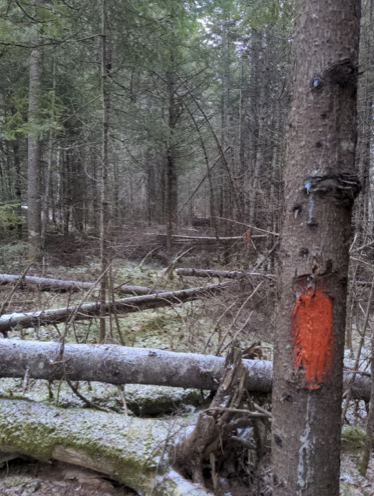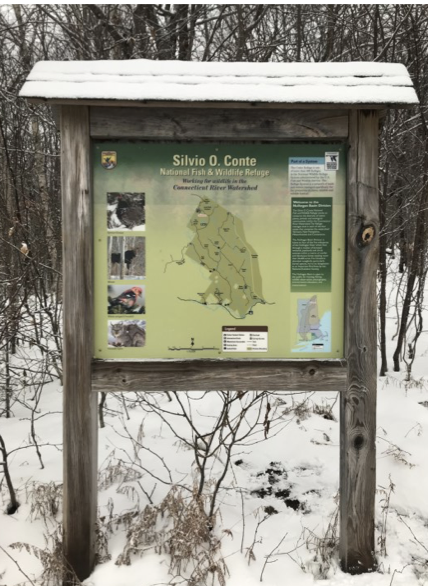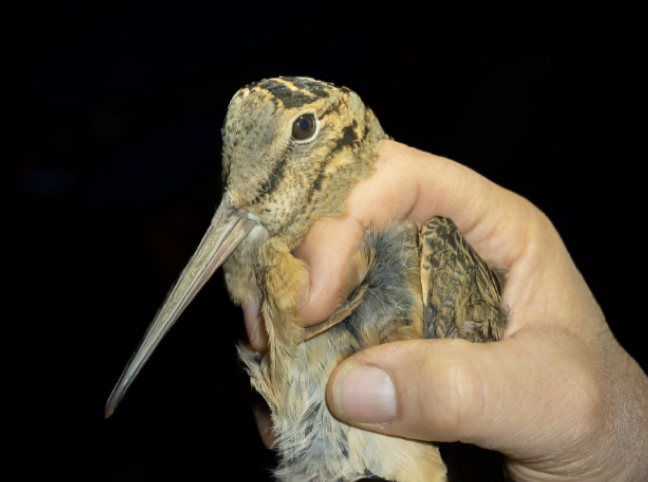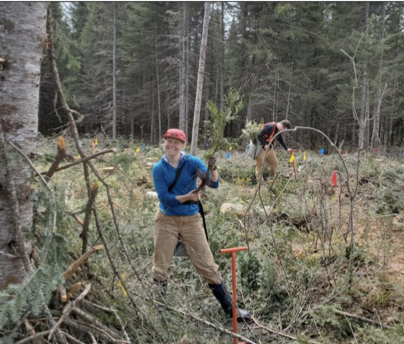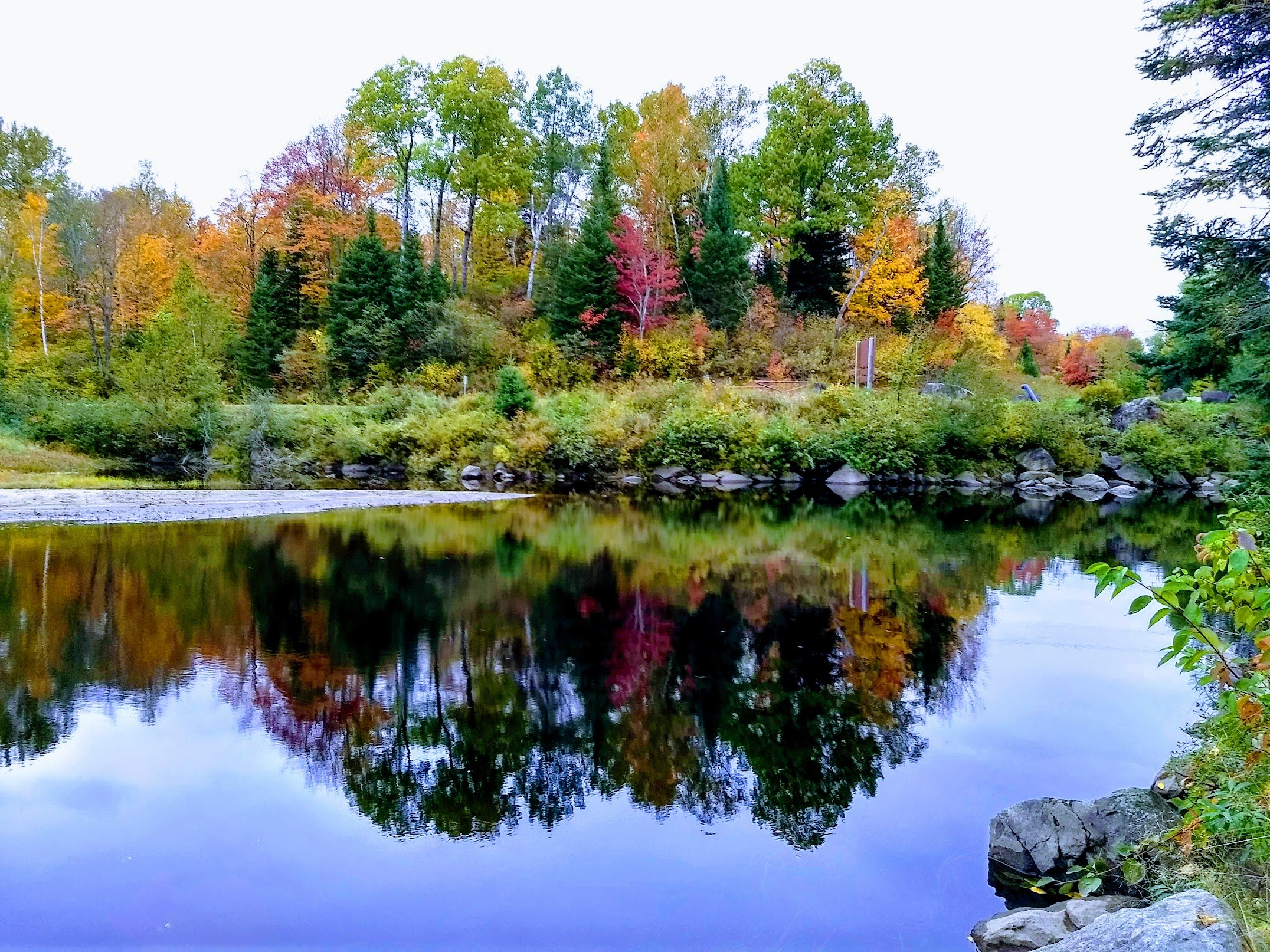
News from Refuge Happenings
The Nulhegan Basin Division is one of 22 Divisions/Units of the Silvio O. Conte National Fish and Wildlife Refuge. Refuge Happenings is a newsletter published by Silvio O. Conte National Fish and Wildlife Refuge, reporting what’s happening at its ten divisions and twelve units. Below are excerpts describing happenings at Nulhegan Basin Division . The full Refuge Happenings newsletters can be found on the Conte Refuge News Page. The U.S. Fish and Wildlife’s Newsroom has a wealth of news articles organized by category: Endangered Species Act, Get Involved, Land Management, Migratory Species, Recreation, Wildlife Management, and Wildlife Wonders.
Refuge Happenings 2022:
Although the Friends of the Nulhegan are focused on the Nulhegan Basin Fish and Wildlife Refuge in Brunswick, Vermont, the staff at the Nulhegan headquarters are responsible not only for the Nulhegan Basin Refuge, but for all the Conte lands in VT and NH listed below. The excerpts below therefore also include reports about work the Nulhegan staff has been doing on other Conte lands.
Making Our Mark In The Christmas Bird Count
Conte staff surveyed winter birds within the Nulhegan Basin Division as part of the annual Island Pond Christmas Bird Count. Bird activity on the refuge seemed subdued this year. The windy conditions may have kept many of them hiding under cover. Ten species were recorded including black-capped and boreal chickadees, gray jays, various woodpeckers, ravens, grosbeaks, siskins, ruffed grouse and nuthatches. Efforts were made to locate the three- toed woodpecker that was documented by a birder weeks before the count, but it did not present itself. A non-birding highlight was the sighting of two otters eating fish on the ice of the Black Branch.
For more information contact: Rachel_Cliche@fws.gov
Chickadee
Photo Credit: Colin Canterbury of USFWS
Boundary Marking at Blueberry Swamp
Refuge staff spent time this month marking property boundaries within the 1,300 acre Blueberry Swamp Division. Properly marking refuge boundaries is animportant component of land management, and serves to protect the investment that the American public has made in Refuge and other federal lands. In total, staff will traverse more than 8.5 miles of property while marking refuge boundaries this winter.
For more information contact: Jeremy_Goetz@fws.gov
On The Lookout For Birds At The Big Sit
The Big Sit! is a free, annual, international birding event open to anyone, anywhere in the world. The Friends of Pondicherry sponsored the annual event at Pondicherry National Wildlife Refuge. It was a big hit for eight volunteers who recorded 36 different species of birds at Cherry Pond in New Hampshire. The team of Big Sit birders greeted more than 100 visitors who made the mile and a half hike to get to the viewing platform. With fall foliage at its peak, the birding and colorful views made for a fun weekend.
For more information contact: Steve_Agius@fws.gov
The Big Sit! at Cherry Pond
Photo Credit: USFWS
Wildlife Population Monitoring At Nulhegan Basin
Effectively managing wildlife across large geographic areas requires an understanding of wildlife population dynamics. Conte Refuge staff and partners have deployed a large network of game cameras across a grid system to increase species detections in the northern part of the Connecticut River watershed. These cameras provide observational data for various research projects, including an investigation into climate change impacts on winter tick and moose populations, and another, studying species diversity where young forest and mature forest habitats overlap. The Refuge uses the data to track species of concern such as Canada lynx. Camera species observation data is housed within a USGS database where it is tagged, organized, and stored for later use. This data can then be used by the Refuge and partners to create species distribution maps and track snowpack and phenological data.
For more information contact: Rachel_Cliche@fws.gov
Conservation Partnership In The Mascoma River Watershed
The Mascoma River watershed is a Conservation Focus Area for the Conte Refuge. Refuge staff are actively collaborating with conservation partners Bear Hill Conservancy, Wild Landscapes, Redstart Consulting, and Moosewood Ecological, to collect biological, ecological and infrastructure data on and off refuge lands in the watershed. The Mascoma River Division conservation easement is a unique opportunity to leverage federal and private funding opportunities to improve and conserve diverse habitats in northern New England.
For more information contact: Steve_Agius@fws.gov
Mascoma River Watershed
Photo Credit: USFWS
Winter Recreation Refuge Interpretation
As the seasons change, so do the types of uses that occur on Refuge lands. To effectively communicate and educate the public about the work of the Service, Conte Refuge staff have been upgrading outdoor interpretive signage across the refuge. At the Nulhegan Basin Division, new interpretive signs have been installed in areas that are frequented by winter enthusiasts of the Refuge. Snowmobiling is a popular winter activity on the Refuge. The Lewis Pond overlook is widely recognized as being one of the most scenic views in northeastern Vermont that is accessible to snowmobiles. A large interpretive panel was recently installed at the scenic overlook to educate snowmobilers about the Conte Refuge and the National Wildlife Refuge System.
For more information contact: Steve_Agius@fws.gov
Headquarters Realty Chief Visits Mascoma Division Of Conte Refuge
Eric Alvarez, Chief of Realty for the U.S. Fish and Wildlife Service, visited the Conte Refuge this month, traveling to the Nulhegan Basin (VT) and Pondicherry (NH) Divisions (both approved by the Migratory Bird Conservation Commission), the Mascoma River Division (NH), Dead Branch Division (MA), and Fannie Stebbins Unit (MA). During his visit, Eric met with Refuge Staff at Nulhegan Basin, David Govatski, who is the President of the Friends of Pondicherry, and a landowner, David Roby, at the Mascoma River Division. Eric and Mark Maghini, Regional Chief of Realty, looked at a 2,470 acre parcel in the Mascoma River Division for potential inclusion in the FY23 Migratory Bird Conservation Plan, and the potential purchase of an easement in FY23 using Migratory Bird Conservation Funds. Also attending the meeting were other leaders and decision makers in conservation work, including: Dan Bergeron, Chief, Wildlife Division for the NH Fish and Game; Markelle Smith, Director of Friends of Conte and Conservation Partnerships Director with Mass Audubon; Jim O’Brien, NH-TNC Director of External Affairs; and Tom Geser, Senior Realty Specialist, USFWS
For more information contact: Andrew_French@fws.gov
Meeting with Chief of Realty, Eric Alvarez
Photo Credit: USFWS
Infrastructure Assessment At Mascoma Division
Conte Refuge staff are collaborating with Bear Hill Conservancy, Wild Landscapes, and Redstart Consulting to draft a management plan for the division in New Hampshire. In October, Conte Refuge staff collected infrastructure data that will be compiled as part of the baseline report for the property. This is an ongoing project that requires an extensive assessment of the property.
For more information contact: Steve_Agius@fws.gov
Mascoma Division
Photo Credit: USFWS
Woodcock Migration Study
The Nulhegan Basin Division was one of two Vermont capture sites for the Eastern Woodcock Migration Research Cooperative, an international research collaboration led by the University of Maine to better understand the migratory ecology of the American woodcock along the Eastern Seaboard. This study uses Global Positioning System (GPS) technology to track the seasonal movement and habitat selection of American woodcock as they travel from their breeding grounds in Canada and northeastern U.S. to their wintering areas in the southern part of the U.S. A total of 4 woodcock from the Division were captured and outfitted with GPS units in October. Field work was led by PhD students from the University of Maine. To follow tagged birds as they migrate to southern wintering grounds, visit www.woodcockmigration.org.
For more information contact: Rachel_Cliche@fws.gov
Improving Fish Passage In Vermont
Conte Staff worked with the Fish and Aquatic Connectivity program this month to replace two perched and undersized culverts with more resilient and suitable steel bridges. The project took place on private land and improved aquatic connectivity on two tributaries to the Nulhegan River which runs through Nulhegan Division of the Conte refuge.
For more information contact: David_Sagan@fws.gov
Replacing Culverts to Improve Fish Passage
Photo Credit: USFWS
Keeping It Safe
The Mud Pond Trail and Boardwalk at Pondicherry National Wildlife Refuge is a popular destination for local residents and visitors to the area. The 900 foot boardwalk meanders through a forested wetland and ends at an observation platform overlooking Mud Pond. The wooden boardwalk requires annual maintenance to keep it operational. In October, Refuge Manager Steve Agius spent a rainy day replacing rotten sections of the Boardwalk.
For more information contact: Steve_Agius@fws.gov
Keeping Roads Cleared
With over 40 miles of publicly accessible gravel roads, annual road maintenance is a perpetual project at the Nulhegan Basin Division. During the month of October, the Refuge’s tractor and boom mower were used to cut the roadside shoulders at the Nulhegan Basin Division. This ongoing preventative maintenance reduces the amount of woody growth that accumulates along the roadsides.
For more information contact: Jeremy_Goetz@fws.gov
One of Over 40 Miles of Gravel Roads on the Refuge
Photo Credit: USFWS
Jessup’s Milkvetch Restoration
Jessup’s milkvetch is a federally listed species that is endemic to the Upper Connecticut River watershed. Jessup's milkvetch seedlings were planted in the spring of 2022 to augment current populations at various sites along the Connecticut River. Volunteers watered these seedlings and tracked their survival throughout the summer. Due to their efforts, there was a high survival rate across all sites, including 75 percent survival on refuge lands.
For more information contact: Rachel_Cliche@fws.gov
Jessup’s Milkvetch
Photo Credit: USFWS
Vermont Forest Roundtable Presentation
Conceived of and convened by Vermont Natural Resources Council in 2006, the Roundtable is a venue for the exchange of information relating to forest policy and keeping Vermont’s forests as forests, with particular attention focused on addressing parcelization and forest fragmentation. In September, the annual Vermont Forest Roundtable meeting was held in Waitsfield, VT. At the annual meeting, Refuge staff provided a presentation about the ongoing Adaptive Silviculture for Climate Change research at the Nulhegan Basin Division.
For more information contact: Steve_Agius@fws.gov
Weather Station Maintenance
The Nulhegan Basin Division is home to a Remote Automatic Weather Station. This is one of more than 2,200 such stations strategically placed around the US. These stations monitor the weather and provide weather data that assists land management agencies with a variety of projects such as monitoring air quality, rating fire danger, and providing information for research applications. To accurately measure particular weather variables, the station's surrounding must be free of tall vegetation. In September, Refuge staff cleared the area around the station to more easily maintain vegetation growth into the future.
For more information contact: Jeremy_Goetz@fws.gov
Clearing Around the Remote Automatic Weather Station
Photo Credit: USFWS
Pondicherry Aquatic Plant Inventory
Local field ecologists inventoried aquatic species within Pondicherry Division’s Cherry, Little Cherry, and Mud Ponds, and within the Nulhegan Basin Division’s Lewis Pond. This inventory will provide baseline data including species composition and abundance, as well as locations of common, rare and invasive aquatic species. The ecologists are finishing up their field work, but an exciting find was rediscovering northern arrowhead, a state endangered species that was first discovered 115 years ago!
For more information contact: Rachel_Cliche@fws.gov
Conducting Aquatic Plant Inventory at Pondicherry
Photo Credit: David Govatski
Regional Moose Management Meeting
Conte Refuge staff attended the regional northeast moose management meeting at Dartmouth College’s Second College Grant in Coos County, New Hampshire. The annual meeting was held to discuss ongoing moose research, habitat management and landscape level population management. In attendance were state biologists from Maine, Massachusetts, New Hampshire, New York and Vermont, the province of Quebec and the U.S. Forest Service.
For more information contact: Steve_Agius@fws.gov
Great American Outdoor Act Deferred Maintenance Project
A four-person Great American Outdoor Act Deferred Maintenance Strike Team spent two weeks working on the exterior of the Nulhegan Basin Office/ Visitor Center. The maintenance crew rebuilt the cupolas, replaced most of the trim along the roof line/windows, replaced rotten clapboards and re-flashed areas that required attention. A big thank you to the New Hampshire crew for their support of the Conte Refuge.
For more information contact: Steve_Agius@fws.gov
Maintenance Work on the Refuge Visitor Center
Photo Credit: USFWS
Youth Conservation Corps
Photo Credit: USFWS
Youth Conservation Corps End of the Season Celebration
The Northern Conte Youth Conservation Corps (YCC) program wrapped up its season in early August. The six-person crew worked at the Nulhegan Basin (VT) and Pondicherry (NH) Divisions throughout the summer. The work focused primarily on repairing and upgrading trails on the refuge and general infrastructure maintenance. At the end of the season the YCC crew had an end of the year celebration with all the other 2022 conservation corps crews at the NorthWoods Stewardship Center.
For more information contact: Steve_Agius@fws.gov
Woodcock Habitat Management
Refuge staff have been mowing woodcock roosting ‘fields’ in the three early successional demonstration management areas in advance of the upcoming deployment of satellite transmitters on woodcock. The research is part of a regional woodcock migration and habitat utilization project that is based out of the University of Maine. This is the third year that the refuge is partnering with the Vermont Department of Fish and Wildlife, Vermont Audubon, Vermont Nature Conservancy and the Wildlife Management Institute on the project.
For more information contact: Steve_Agius@fws.gov
American Woodcock
Photo Credit: USFWS
Participating in the Clean-up of Old Tires at Putney Mountain
Photo Credit: USFWS
Clean Up At Putney Mountain
This month Conte Refuge staff removed a truck load of old tires that had been dumped illegally at our Putney Mountain Unit. Unfortunately, illegal dumping is something that still happens on National Wildlife Refuges, detracting from quality habitat and quality outdoor recreational experiences. To help, please report any signs on dumping you might see.
For more information contact: Dean_Rhine@fws.gov
Post Treatment Sampling of Adaptive Silviculture for Climate Change Research Project
This summer, the Northwoods Youth Conservation Corps worked on numerous projects, making needed improvement throughout the Refuge. Accomplishments included trail improvements in both New Hampshire and Vermont, which entailed removing downed trees, clearing brush, and replacing sections of a rotten bog bridge. A notable project they completed was constructing a public bike service station along the Presidential Rail Trail at the Pondicherry Division.
For more information contact: Steve_Agius@fws.gov
NorthWoods Youth Conservation Corps
Photo Credit: Bob Holdworth
Pollinator Sampling Station
Credit: USFWS
NorthWoods Conte Youth Conservation Corps Crew
Pollinators are declining globally due to climate change, pesticide use, and habitat loss. Recent and rapid bumblebee species decline has generated conservation concerns resulting in petitions for listing of several species under the Endangered Species Act. The Conte Refuge is participating in a regional pollinator sampling survey on divisions in New Hampshire and Vermont. In July, sampling stations were set up at the Blueberry Swamp, Nulhegan Basin and Pondicherry Divisions of the Conte Refuge to assess pollinator species diversity on the refuge.
For more information contact: Rachel_Cliche@fws.gov
Post Treatment Sampling of Adaptive Silviculture for Climate Change Research Project
Field technicians from the University of Vermont have begun post-treatment sampling within the Adaptive Silviculture for Climate Change study occurring on the Nulhegan Basin of the Conte Refuge. Sampling efforts include vegetation measurements in treated areas, including baseline measurements for each of more than 10,000 seedlings that were planted post-harvest. This allows researchers to track tree seedling growth and mortality over time. Technicians continue to characterize the bird community within the study site; a second year of species occurrence data has been gathered to evaluate treatment impacts.
For more information contact: Steve_Agius@fws.gov
Canada Warbler, one of the bird species living on the Refuge
Photo Credit: Unknown
Youth Conservation Corps Crew
from NorthWoods Stewardship Center
Credit: NorthWoods Stewardship Center
NorthWoods Conte Youth Conservation Corps Crew
In June, the NorthWoods Conte YCC crew began working on the trails at the Conte Refuge. This season, the six-person crew will work at the Nulhegan Basin, Pondicherry and Blueberry Swamp Divisions on trail repair, road/building infrastructure and boundary posting projects. In addition, the crew will be working on a Partners For Fish and Wildlife project to improve public access to the Connecticut River at Lyman Falls in New Hampshire.
For more information contact Steve_Agius@fws.gov
Media Interest In The Adaptive Silviculture For Climate Change Research
There continues to be a considerable amount of public interest and media attention regarding the Adaptive Silviculture for Climate Change research project at the Nulhegan Basin Division. In June, reporters from local and statewide newspapers reported on the climate change research project. WCAX (CBS affiliate) aired a piece on their evening news about the project. Additionally, National Public Radio had a segment about the project on the nationally syndicated ‘All Things Considered’.
For more information contact: Steve_Agius@fws.gov
Planting Tree Seedlings
for Adaptive Silviculture for Climate Change Research
Photo Credit: UVM
Wildlife Camera Attached to Tree Trunk
Photo Credit: USFWS
Monitoring Furbearer And Moose Populations Using Camera Traps
Nine cameras were deployed within the Pondicherry Division’s forested habitats in June to evaluate monitoring methods for furbearers and moose in New Hampshire. This state-wide research effort is a cooperatively funded partnership between the University of New Hampshire and the New Hampshire Fish and Game Department. Cameras are being deployed across New Hampshire within various habitat types and elevation gradients to evaluate wildlife-habitat relationships and to improve predictive accuracy of species distribution models and abundance estimates. This information will be used to inform wildlife management and conservation in the state.
For more information contact: Steve_Agius@fws.gov
Bee Survey In Vermont
Ecologists from the Vermont Center for Ecostudies conducted a bee survey within conifer and bog habitats of the Nulhegan Basin Division. This effort is part of the Vermont Wild Bee Survey. The main objectives of this regional effort is to document bee species in Vermont, assess conservation status of species and identify habitats of statewide and regional importance. Approximately 40 species were documented in a one-day survey of the refuge including parasitic bees, bumble bees and miner bees. Another survey will be conducted mid-summer to document additional bee species.
For more information contact: Rachel_Cliche@fws.gov
Bee Sipping from a Red Clover
Photo Credit: Kent McFarland
Two Youths Displaying the Fish They Caught Photo Credit: USFWS
Youth Fishing Event
NorthWoods Stewardship hosted its annual Youth Fishing Event in collaboration with the Vermont Department of Fish and Wildlife and the U.S. Fish and Wildlife Service. The free public event was an opportunity for local youth to fish a small pond for stocked brook trout. In addition to fishing equipment, instructions were provided on how to cast a spin casting rod and bait a hook.
For more information contact Steve_Agius@fws.gov
Vermont USFWS Managers Meeting with VT Congressional Staff
In May, U.S. Fish and Wildlife Service supervisors from across the state of Vermont met with Vermont Congressional staff at the Missisquoi NWR to discuss ongoing and upcoming projects throughout the state. The annual event is a collaborative opportunity to highlight biological, restoration and partnership projects that are taking place in aquatic and terrestrial habitats in Vermont. This was the first in person meeting held since the spring of 2019.
For more information contact Steve_Agius@fws.gov
Missisquoi NWR Visitor Center
Photo Credit: USFWS
Planting Trees for Adaptive Silviculture Project
Photo Credit: University of Vermont
Adaptive Silviculture For Climate Change Tree Planting
A tenet of both restoration ecology and forest management for climate adaptation holds that ecosystems with a greater diversity of species is more resistant to change and better resilient in the face of change. The Adaptive Silviculture for Climate Change research project at the Nulhegan Basin Division of the Conte Refuge has begun enrichment planting of four tree species within artificially created gaps. These species are thought to have occurred in these areas historically, but their abundance has severely declined due to past management practices. In total, more than 14,000 seedlings were planted throughout the experiment. Seedling survivability, growth, browse pressure, and other attributes will be monitored for the length of the experiment.
For more information contact: Steve_Agius@fws.gov
Stream Assessment For Future Culvert Replacement
USFWS staff from Hadley, MA (hydraulic engineer and fish passage biologist) conducted a site assessment of a failing road crossing on the Eagles Nest Road at the Nulhegan Basin. The structural integrity of the existing culvert (former RxR tanker car) has been compromised and new road crossing structure is being designed for the site. The site assessment included gathering topographic data of the road and stream corridor to aid in the design of a structure that is appropriate for aquatic organism passage.
For more information contact: Steve_Agius@fws.gov
Road Crossing on the Eagles Nest Road at the Nulhegan Basin
Photo Credit: USFWS
Introducing Ash Pounding
Photo Credit: USFWS
Black Ash Splint Pounding Draws A Crowd At Nulhegan
Black ash trees have been used for generations as a high quality pliable wood product that can be 'woven' into intricate products. In May, a cultural event was held at the Nulhegan Basin Division, teaching the public about pounding black ash splints and the looming threat of the invasive emerald ash borer. Black ash (also know as brown ash) can be pounded to separate the annual growth rings from one another. The separated growth rings are pulled into strips called splints. The flexible splints are a versatile product that can be used to make an assortment of items from pack baskets to fancy decorative baskets. There is a growing concern that emerald ash borer will kill the majority of ash across the northeast and that black ash will be a species that disappears from the landscape. Part of the event focused on educating the public on how to identify the insect and its telltale 'D' shaped holes in ash trees.
For more information contact: Steve_Agius@fws.gov
Mascoma Division Infrastructure Inventory
In collaboration with Bear Hill Conservancy, WildLandscapes, and Redstart Consulting, efforts are underway to collect baseline biological, ecological, and infrastructure data for the Mascoma Division. Conte Refuge staff visited the division in April to survey infrastructure on the property. Numerous stone foundations, cellar holes, and stone walls are scattered across the property.
For more information contact: Steve_Agius@fws.gov
Stone Remains at Mascoma Division
Photo Credit: USFWS
Llamas help install benches along rail trail at Pondicherry
Photo Credit: Dave Govatski
Leopold Bench Installation at Pondicherry
The XNHAT (Cross New Hampshire Adventure Trail) installed two Aldo Leopold benches along the rail trail at Pondicherry on April 20th using llamas to haul in the materials. Each bench will have a QR code that describes a particular aspect of the Pondicherry environment. All of the benches are on the State owned rail trail that provides access to the Refuge.
For more information contact: Steve_Agius@fws.gov
Nulhegan Basin Division Tree Planting
A tenet of both restoration ecology and forest management for climate adaptation holds that ecosystems with a greater diversity of species are more resistant to change and have better resilience in the face of change. The Adaptive Silviculture for Climate Change research project at the Nulhegan Basin Division of the Conte Refuge has begun enrichment planting of four tree species within artificially created gaps. These species are thought to have occurred in these areas historically, but their abundance has severely declined due to past management practices. In total, more than 12,000 seedlings will be planted throughout the experiment. Seedling survivability, growth, browse pressure, and other attributes will be monitored for the length of the experiment.
For more information contact: Steve_Aguis@fws.gov
Nulhegan Basin Division Tree Planting
Photo Credit: USFWS
Wildlife Photos by Tom Berriman on Display
Photo Credit: USFWS
Vermont Wildlife Photographer Donates Pictures to the Refuge
Tom Berriman, a wildlife photographer from northern Vermont, donated one dozen large format framed pictures of birds found on the Refuge. The pictures include black-backed woodpeckers, gray jay, spruce grouse, evening grosbeak, barred owl, and sharp shinned hawk. The pictures are being displayed on many of the walls in the Nulhegan Basin Visitor Contact Station.
For more information contact: Steve_Agius@fws.gov
Vermont Jr. Duck Stamp Contest Held At Nulhegan Division
Ellery Norwood of East Burke, VT has been awarded the Best of Show for the second year in a row, in the 2022 Federal Junior Duck Stamp Design Contest. Judging for the contest took place at the Nulhegan Basin Division of the Conte Refuge earlier this month. Ellery is a student at the Lyndon Institute and entered a painting of a mallard duck into the contest. Her winning piece will now compete in the National Jr. Duck Stamp Contest and will be included in an exhibit that will tour the U.S. this coming year. Congratulations Ellery! Learn more about the Jr Duck Stamp Program.
For more information contact: Steve_Agius@fws.gov
VT Jr. Duck Stamp Contest Winner Ellery Norwood of East Burke
Photo Credit: USFWS
Conte Staff and Volunteers Moving Tamarack Bog Bridge Planks at Pondicherry NWR
Photo Credit: USFWS
Pre-Season Trail Work At Pondicherry
In March, Conte Refuge staff moved dozens of tamarack bog bridge planks to staging areas at the Pondicherry Division in NH. The wooden planks were first transported with a snowmobile and utility trailer. Once the planks were unloaded at the staging areas, local volunteers worked together to carry the planks to sections of trails that will be upgraded by the YCC crew this summer.
For more information contact: Steve_Agius@fws.gov
Conte Corner at Fairbanks Museum
In January a new interpretive exhibit was installed at the Fairbanks Museum in Saint Johnsbury, Vermont. The newly installed ‘Conte Corner’ is a hands-on exhibit that provides information about the U.S. Fish and Wildlife Service, the National Wildlife Refuge System, the Silvio O. Conte National Fish and Wildlife Refuge, and the Connecticut River watershed. The exhibit is the first of many collaborations between the refuge and the museum. Refuge staff are currently working with the staff at the museum to develop a Turtles of New England exhibit and an Illegal Exotic Wildlife Trade exhibit.
For more information contact: Steve_Agius@fws.gov
The new Conte Corner in the Fairbanks Museum
Photo Credit: USFWS
Motus Radio Telemetry Array
Photo Credit: USFWS
Motus Radio Telemetry Array Installed at the Nulhegan Basin Division
A Motus Wildlife Tracking Station was installed at the Nulhegan Basin Division. A second one has been located on the Fort River Division for several years. This new station uses automated radio telemetry antennas attached to a radio tower, and a receiver to record signals from passing telemetry tagged birds, bats and insects. Motus stations are located throughout the world to track migratory animals in an effort to learn about their ecology. This is a coordinated effort between researchers, educators and citizen scientists. Data captured from individual animals are uploaded and housed in a central database that is managed by Bird Studies Canada, a Canada -based nonprofit. These data can be analyzed and shared among partners and the public. To learn more about Motus, visit: https://motus.org/.
For more information contact: Steve_Agius@fws.gov
Winter Snow Track Survey
Snow conditions were appropriate in February for Refuge staff to conduct a winter track survey. These surveys occur along linear transects within the vicinity of refuge cameras to document occurrence of Canada lynx. Surveyors use snowmobiles and snowshoes to assess tracks placed 48-hours after a snowfall or wind event. All species tracks are recorded in a notebook. Lynx tracks, if detected are GPSed, photographed and measured. Lynx were not recorded during this year’s survey effort. Snowshoe hare and red squirrel were abundant, and it was noted that moose presence seemed to be low this year.
For more information contact: Steve_Aguis@fws.gov
Winter Snow Track Survey
Photo Credit: USFWS
Adaptive Silviculture for Climate Change:
Machine Harvesting Timber
Photo Credit: USFWS
Adaptive Silviculture for Climate Change: Completion of Timber Harvest
As part of a collaborative effort to establish a series of experimental silvicultural trials across a network of different forest types, a variety of adaptation treatments were implemented at the Nulhegan Basin of the Silvio O. Conte National Fish and Wildlife Refuge and monitored by researchers with the University of Vermont. Scientists, resource managers, and a variety of partners have developed a 550 acre trial site to research long-term ecosystem responses to a range of climate change adaptation actions within a lowland mixed conifer forest. The treatments are designed to test various approaches intended to increase structural complexity and species diversity within the forest, with the ultimate goal of improving habitat for specific wildlife species. Partners include the University of Vermont, University of New Hampshire, Dartmouth, US Forest Service, and the Northern Institute of Applied Climate Science. The timber harvesting component of the project was completed in February, 2022.
For more information contact: Steve_Agius@fws.gov
Tour of the Adaptive Silviculture for Climate Change Research Project at the Nulhegan Basin Division
Approximately 20 members of the local community braved -45 F degree wind chills to participate in a field tour of an ongoing forest management project at the Nulhegan Basin Division of the Silvio O. Conte National Fish and Wildlife Refuge. Refuge staff discussed the land-use history of the project area, the origins of the partnership between the Refuge and academic partners, and the experimental design of the treatment. Tour participants spoke directly with loggers working for Stephane Inkel Logging, Inc. about their equipment and the difficulties associated with working in such extreme cold. To learn more about the research, visit: https://forestadaptation.org/adapt/demonstrationprojects/us-fish-and-wildlife-service-and-university-vermont-nulhegan-basin
For more information contact: Steve_Aguis@fws.gov
January Tour Group Views Harvesting Machine
Photo Credit: USFWS

